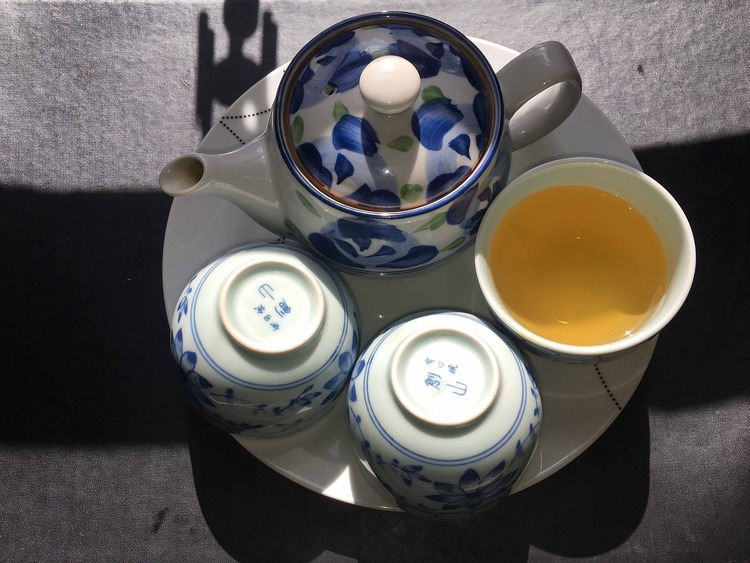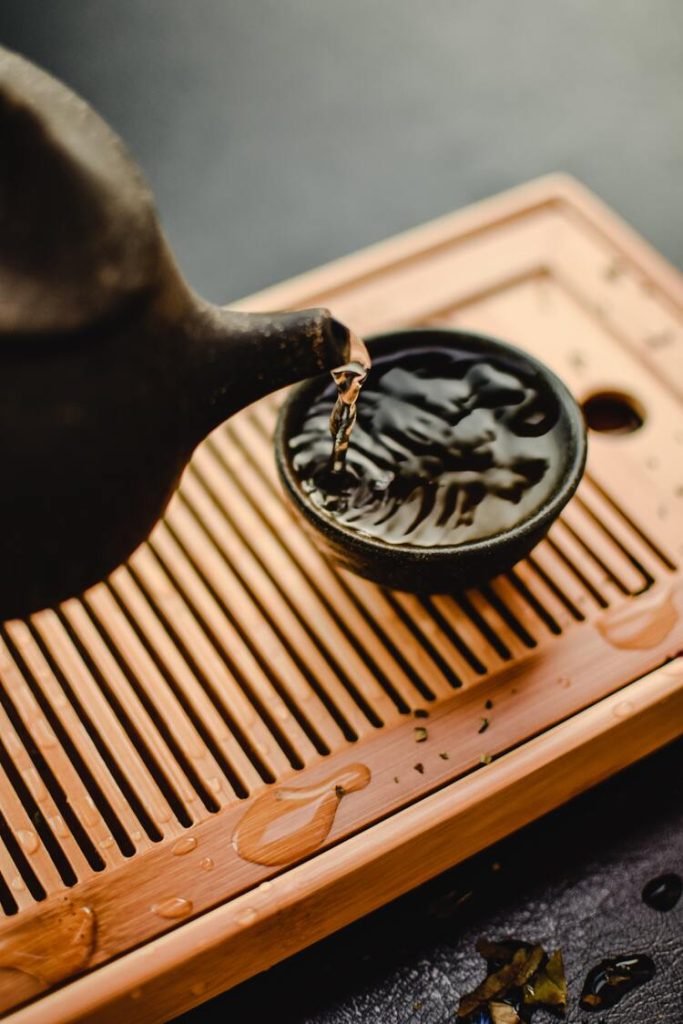Taiping Houkui tea is one of China’s most revered teas. This green tea is grown in the mountains of the Anhui province and is known for its long, flat leaves and delicate flavor.
What sets Taiping Houkui apart from other green teas is a mix of the cultivar from where the leaves come from and the production process. The leaves are hand-picked and then pan-fired in small batches, giving them a distinctive shape and flavor. The resulting tea is light and refreshing, with a subtle sweetness and a hint of nuttiness.
Join us as we explore this tea known for its numerous awards.
Please note: This article contains affiliate links, meaning I may earn a commission if you make a purchase by clicking a link. Of course, this comes at no extra cost to you and helps me keep offering readers solid information.

The Origin of Taiping Houkui Tea
Taiping Houkui originated near the Huangshan mountain range in Taiping County, Anhui Province. The tea is grown in the high mountains, where the climate and soil are perfect for growing tea.
The story goes that a tea farmer named Wang Kuicheng refined the process of producing tea from a hybrid or cultivar growing on the mountainside. This plant had large, straight leaves, very different from what he had seen before.
Word of Wang’s exceptional quality tea soon spread and became popular among tea connoisseurs. In the 20th century, Taiping Houkui won several awards at the China Tea Exhibition, cementing its status as one of the best teas in the country.
Today, Taiping Houkui Tea is still grown in the same region, using the same traditional methods passed down for generations.
Houkui means monkey leader. Therefore, the complete name of the tea is Taiping monkey leader. Even though the name sounds a bit bizarre, it has an explanation. Taiping is the name of the county where the tea is grown. Monkey refers to Monkey Valley (Houkeng), where Wang developed the tea. Leader comes from the character “kui, ” part of Wang’s name. So, the tea was named after its place of origin and inventor.
Cultivation and Harvesting
The tea trees used to produce Taiping Houkui are grown on the steep slopes of the Huangshan region. The tea trees are grown at an altitude of 800 to 1,200 meters.
The tea is produced using the cultivar called “Shidaye.” This cultivar is known for its large, flat leaves and the enormous buds at the end of each stem. These buds are covered in delicate white hairs, which give them a soft and fuzzy appearance. The big leaves create a striking visual contrast with the bud.
The fresh leaves used to produce the tea are harvested during the Grain Rain and Beginning of Summer periods, which fall between late April and early June. During this time, the tea leaves are at their freshest and contain the highest concentration of nutrients.
Only one bud and two leaves are picked from each tea tree to ensure the highest quality. This selective picking process allows the tea leaves to develop a unique flavor and aroma.
The weather conditions during the cultivation and harvesting process are also essential. The Huangshan Mountains are known for their high humidity and frequent fog, which create a perfect environment for growing tea trees. The tea trees are also grown in the shade to protect them from direct sunlight, which can damage the leaves.
The soil in which the tea trees are grown is rich in minerals, which adds to the flavor of the tea leaves. The combination of altitude, humidity, fog, shade, and soil creates excellent conditions for growing high-quality tea leaves.

Processing of Taiping Houkui Tea
To create Taiping Houkui tea, the processing method is key. The leaves must be carefully handled to preserve their delicate flavor and aroma. Here’s how it’s done:
- Harvesting: The leaves are picked in the early spring when they are freshest and most tender.
- Withering: The leaves are spread out and wilt for several hours. This reduces the moisture content and makes them easier to work with.
- Fixing: The leaves are heated in a wok to stop the oxidation process (darkening of the leaves). Traditionally, this is done by carefully pan-firing the leaves in large woks and repeatedly shaking them to prevent over-roasting. The fixing process helps preserve the fresh green color and natural flavors of the tea.
- Rolling: The leaves are rolled into long, thin strips using two knives and one pole. This process helps to release the tea’s natural oils and flavors.
- Baking: The leaves are baked at a low temperature to dry them out and preserve their freshness.
- Roasting: The leaves are lightly roasted over charcoal to enhance their flavor and aroma.
- Final Sorting: The tea leaves are sorted and graded according to size and quality.
- Quality Inspection: A quality control check ensures that only the best leaves are selected for the final product.
- Packaging: The finished Taiping Houkui tea is packaged in airtight containers to preserve its freshness and aroma.
The result is a tea that is light, refreshing, and flavorful.
Flavor Profile and Appearance
Taiping Houkui offers a combination of flavors that sets it apart from other green teas. The flavor profile can be described as follows:
- Sweetness: Taiping Houkui has a natural sweetness from the tender, young tea leaves used in its production. This sweetness is subtle and pleasant without being overpowering.
- Vegetal: The tea has a distinct vegetal character, reminiscent of steamed greens or fresh vegetables. This flavor is often compared to asparagus or spinach but is lighter and more refined.
- Orchid-like Aroma: The tea emits a floral aroma with notes of orchids, which adds a delightful and fragrant aspect to the overall experience.
- Umami: Some varieties of Taiping Houkui may exhibit a slight umami taste, similar to what is found in high-quality Japanese green teas like Gyokuro or Matcha. This umami flavor enhances the tea’s complexity.
- Creamy: In some instances, Taiping Houkui can have a creamy mouthfeel, contributing to its smooth and rich texture.
- Refreshing: The tea has a vital quality that leaves a clean and crisp sensation on the palate, making it a pleasant and revitalizing drink.
- Mild Bitterness and Astringency: Taiping Houkui should have minimal bitterness and astringency when appropriately brewed. However, it may develop slight bitterness or astringency if over-brewed or steeped at too high a temperature.
Taiping Houkui tea’s appearance distinguishes it from other green teas. The tea leaves are long, straight, and flat, with a slight curve towards the end. The leaves are a vibrant green with a glossy sheen that catches the light.

Brewing Taiping Houkui Tea
When it comes to brewing Taiping Houkui, there are a few techniques and considerations you should keep in mind to ensure that you get the best flavor out of your tea.
Steeping Time
The steeping time is crucial to achieving the perfect balance of flavor and aroma. Generally, green tea should be steeped for 2-3 minutes. Steeping for too long can produce a bitter taste, while steeping for too short can produce a weak flavor.
Boiling Water
Green tea can be brewed with water that is around 160°F (71°C) to 180°F (82°C). If you don’t have a thermometer, you can boil the water and let it cool for a few minutes before using it.
Filtered Water
Filtered water is always recommended when brewing tea, as it can greatly improve the flavor and aroma. Tap water can contain impurities that can affect the taste of your tea, so using filtered water can help ensure a cleaner, better-tasting cup.
Brewing Techniques
There are several brewing techniques you can use when brewing green tea. Here are a few to consider:
- Covered Cup or Gaiwan: This method involves warming the cup or gaiwan and adding the tea leaves and hot water. Then, the brewing vessel is covered with a lid while the leaves are steep. This is the recommended brewing method to obtain the best flavor.
- Grandpa Style: This method involves placing the tea leaves directly in a cup and adding hot water. It’s a simple and convenient way to brew tea, but it can produce a weaker flavor.
- Western Style: This method involves using a larger teapot. It’s a good option if you want a stronger flavor and don’t have much time.
Health Benefits and Nutritional Value
One of the most significant benefits of Taiping Houkui tea is its high polyphenol content. Polyphenols are a type of antioxidant that can help protect your body against damage from free radicals. These antioxidants can also help reduce inflammation linked to many chronic diseases.
In addition to polyphenols, the tea contains a range of minerals, including calcium, potassium, and magnesium. These minerals are essential for maintaining healthy bones and muscles and regulating blood pressure and other bodily functions.
Another important component of Taiping Houkui tea is caffeine. While too much caffeine can be harmful, moderate amounts can provide many benefits, including increased energy and improved mental focus.
Finally, Taiping Houkui contains a variety of amino acids, which are the building blocks of proteins. These amino acids can help support muscle growth and repair and boost your immune system.

Buying Recommendations & Authenticity
When it comes to Taiping Houkui tea, authenticity is essential. Unfortunately, there are many fake versions of the tea on the market. These fake versions can be made from low-quality tea leaves or even other types of tea altogether. This can lead to a disappointing experience for the drinker.
To ensure that you are getting the real thing, it’s important to purchase Taiping Houkui Tea from a reputable source. Look for tea that comes from the original production area, which is in Houkeng Village in Anhui Province, China. Additionally, look for tea certified by the China National Tea Quality Supervision and Inspection Center.
One way to spot a fake Taiping Houkui Tea is to examine the tea leaves. The real tea leaves are long and flat, with a distinct shape and color. The leaves should be a deep green color with a slight shine. Fake tea leaves may be shorter, darker, and have a different shape.
Another way to spot a fake is to examine the packaging. Authentic Taiping Houkui will often come in a distinctive bamboo basket. The basket should have a label that includes the name of the tea, the production area, and the producer’s name.
A great place to buy this tea is at specialty tea shops. These shops often carry a wide variety of tea blends. Specialty tea shops are also the place to ask questions and get recommendations from knowledgeable staff members who can help you find products according to your preferences and budget.
If visiting a specialty tea shop is not viable, you can look for reputable online tea shops or retailers. You can also read reviews from other customers to get an idea of the quality of the tea and the seller’s reliability.
If you are interested in buying online, please consider the recommendations below.
Taiping Houkui Monkey Chief Tea

Anhui Tai Ping Hou Kui Green Tea

Organic Green Tea Taiping Houkui

Preservation and Freshness
Preserving the tea’s freshness is crucial to maintain its flavor and aroma. Here are some tips to help you keep your tea fresh and flavorful:
- Store your tea in an airtight container to prevent moisture and air from affecting its quality.
- Keep your tea away from strong odors and direct sunlight, as they can alter the flavor and aroma of the tea.
- Avoid storing your tea in the refrigerator or freezer, as the moisture and temperature fluctuations can damage the leaves.
- Use your tea within six months of purchase to ensure optimal freshness and flavor.
One of the characteristics of Taiping Houkui tea is its wet hay aroma. This aroma results from the hand-plucked tea leaves withered and dried in the sun. To preserve this aroma, storing your tea properly and using it within the recommended timeframe is important.
Frequently Asked Questions
How do you properly brew Taiping Houkui Tea?
To properly brew Taiping Houkui, start by heating water to approximately 176°F. Then, rinse the tea leaves with hot water for about 10 seconds before discarding the water. Next, steep the tea leaves in hot water for 2-3 minutes. Finally, strain the tea leaves and enjoy your cup of Taiping Houkui Tea.
What are the health benefits of Taiping Houkui Tea?
This tea has been known to provide several health benefits. These benefits include reducing the risk of heart disease, improving brain function, and aiding in weight loss. Additionally, it has been found to contain antioxidants that help to prevent cancer and lower the risk of chronic diseases.
What is the history of Taiping Houkui Tea?
Taiping Houkui has a rich history dating back to the Qing Dynasty in China. It was first produced in Taiping County, Anhui Province, and was initially known as “Taiping Houkui Tribute Tea.” The tea was given as a tribute to the emperor and was highly valued for its unique taste and aroma.
How is Taiping Houkui Tea different from other green teas?
Taiping Houkui is different from other green teas in several ways. Firstly, it is grown in a specific region of China and is made using a unique processing method that involves roasting the tea leaves over charcoal. This gives the tea a distinct smoky flavor and aroma. The tea leaves are also longer and flatter than other green teas, giving it a unique appearance.
What is the best way to store Taiping Houkui Tea?
To ensure the quality and freshness of Taiping Houkui Tea, it is best to store it in an airtight container in a cool, dry place away from direct sunlight. This will help to preserve the flavor and aroma of the tea leaves.
What is the recommended serving size for Taiping Houkui Tea?
The recommended serving size for Taiping Houkui Tea is approximately 2-3 grams per 8-ounce cup of water. However, this can vary depending on personal preference and the strength of the tea desired.

I hope you have enjoyed the article and learned something new! See you later!
Have you tried this tea?
More About Green Tea
What Does Green Tea Taste Like?
What Does Jasmine Tea Taste Like?
What Does Jasmine Milk Tea Taste Like?